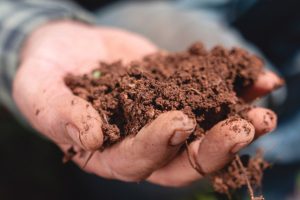Unlocking the Power of Humic Acids:
Your Hub for Nutrient Education
The goal of the Humic Insights page is to provide in-depth and technical knowledge
on the use of humic acid and its impact on soil health and nutrient enhancement.
Humic Insights
The Humic Insights page is a resource for individuals interested in learning about the impact of humic acid on soil health and nutrient enhancement. The page features technical documents on the use of humic acid and its effect on various soil nutrients, including potassium, nitrogen, and phosphorus, with more to come.
The documents featured on the Humic Insights page are highly technical and intended for individuals looking to deepen their understanding of nutrient cycles in soil. Through these technical documents, readers can gain a comprehensive understanding of the relationship between humic acid and the essential nutrients in soil.


Soil Amendment Functions in Comparison with Humic Substances
Today we find different products offered on the market to work the soil more sustainably using more natural sources or using waste from other industries with the purpose of increasing fertility. It is important to make it clear that the use of these materials can be very effective as long as we know very well their function within the soil and of course the variables in which they act so as not to make mistakes and rather to be able to use them appropriately and not commit mistakes. Same mistakes of traditional chemistry in the past.

Microbiology and Health of the Soil
When we refer to organic matter, there are different types and of course, this also influences the type of microflora that we stimulate in the soil when it is incorporated. For example, when we introduce large amounts of organic matter into the soil, we stimulate the development of a large number of certain types of decomposing microorganisms, which are also associated with the type of organic material we are incorporating.

Humic Acids and Potassium
This document describes the different forms of potassium present in soil and their impact on soil fertility. Potassium cations present in the soil solution are taken up by plant roots, while exchangeable potassium is adsorbed on clay and organic colloids and can be improved through the application of humic acids. Non-exchangeable potassium is adsorbed in the interlayer spacing of clay minerals and can be released by humic and fulvic acids.

Humic Acids and Nitrogen
Humic substances play an important role in the process of nitrogen utilization in soil, by inhibiting the activity of the urease enzyme and reducing ammonium concentration during the hydrolysis of urea, which is the most widely used synthetic nitrogen fertilizer. Humic substances also help to reduce nitrogen leaching and increase the reserve of organic nitrogen in the soil, by promoting beneficial fungal and bacterial populations, increasing the total biomass of crop residues, and facilitating the reduction of organic nitrogen to release inorganic nitrogen faster. The presence of organic nitrogen in soil can be measured by the Sugar Amino Nitrogen Test or ISNT test.

Humic Acids and Phosphorus
Soil phosphorus comes in two forms, organic and inorganic, which make up the total of the soil’s phosphorus. Although a soil’s total phosphorus is generally high, most of it is immobile and unavailable to the plant. The presence of humic acids promotes microbe growth and the mineralization process of organic phosphorus, making it available to plants. Humic molecules can also form complexes with phosphate ions to make it available to plants, and they promote mycorrhizal fungi that break down mineral phosphorus.

Humic Acids and Salinity
How does soil organic matter (SOM) impact soil health and crop productivity? SOM is an essential factor in soil fertility, nutrient cycling, and water retention. Maintaining adequate SOM levels is crucial for sustainable agriculture, which can be achieved through practices like crop rotation, reduced tillage, and cover cropping. The use of SOM can improve soil quality, boost crop productivity, and reduce soil erosion. Sustainable agricultural practices that encourage SOM can mitigate the adverse effects of climate change and maintain soil health for future generations.

Humic Acids and Calcium
This document explores the interactions between humics and calcium in soil and their impact on plant growth and soil fertility. Humics can bind to calcium ions, affecting calcium availability to plants. Calcium also affects humics structure, which influences their ability to retain water and nutrients. Therefore, it’s crucial to balance soil nutrients to ensure healthy plant growth and maintain soil fertility. Excessive calcium levels can lead to soil alkalinity, negatively affecting plant growth. Overall, understanding these interactions is crucial to promoting healthy plant growth and soil health.

Fulvic Acids Application in Agriculture
Fulvic acids are natural humic substances extracted from raw humalite or Leonardite, with lower molecular weight and higher oxygen content compared to humic acids. They act as a carrier of trace minerals and substances, and are soluble in water under all pH conditions. Fulvic acids improve micronutrient uptake in plants and can compliment the use of synthetic chelates for better plant uptake and economic efficiency. They are reductive in nature, protecting Fe2+ from oxidation and reducing Fe3+ for improved uptake by plant roots.

The Importance of Organic Carbon in the Soil
Organic carbon plays a critical role in maintaining soil health and fertility. Organic carbon, found in living and dead organic matter, undergoes constant transformation due to microbiological activity, providing nutrients and aiding in mineral solubilization. A small portion of this carbon forms stable humic substances, which contribute to various soil properties and fertility. These substances, particularly humic acids and humins, increase the structural organic carbon in the soil, leading to a slow, constant supply of carbon. This process enhances soil fertility, benefiting activities like agriculture, livestock, and gardening, especially in soils degraded due to intense exploitation.

Water Holding Capacity of Humics
Humic acids, a group of compounds with diverse physical-chemical characteristics, perform various restorative functions in soils, especially those degraded due to intense agricultural exploitation. Humic acids are amorphous molecules with large carbon chains that contain functional groups, allowing them to react with both cations and anions. This bipolarity enables humic acid molecules to attract water molecules, resulting in water retention. A humic acid molecule can retain up to 20 times its molecular weight in water, which can alleviate water stress in crops. The application of humic acids has been shown to improve the texture and structure of degraded soils, increase the soil’s water retention capacity, and promote the formation of humic-clay complexes. Humic acids also enhance the growth of healthy roots in compacted clay soils by incorporating oxygen and aerating the soil. In sandy soils, humic acid acts as a glue to hold the soil together and provide moisture and nutrients around the roots.
